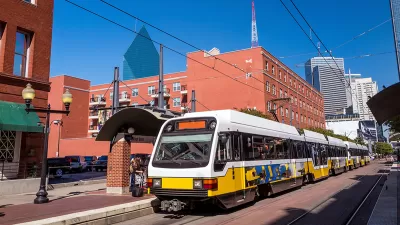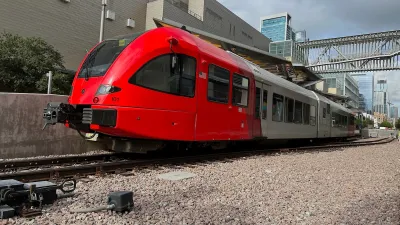30 years ago, voters in North Texas approved a sales tax to fund the Dallas Area Rapid Transit (DART) system based on promises of reducing congestion, spurring development and sustainable funding. Has the system met its goals? Depends who you ask.

"Automobile-loving North Texans took a radical step 30 years ago. That’s when voters in more than a dozen cities approved a 1 percent sales tax to fund Dallas Area Rapid Transit, now America’s largest light rail system," writes Tom Benning. "Tuesday’s anniversary of that hotly contested election is more than just a date on the calendar. The public transportation proposal pitched to voters in 1983 extended out almost three decades exactly: Service plans went to 2010, while the financial strategy stretched into 2013."
"The question, then, is simple: Has DART kept its early promises to those who voted to try something beyond a deeply rooted embrace of cars and seemingly endless highways?"
Take the congestion argument for example. Though 40,000 people ride the rail line every day, presumably taking many cars off the road, "Dallas-Fort Worth is still the 13th-most-congested urban area in America, according to the Texas A&M Transportation Institute."
“Reducing congestion was probably the worst argument they could’ve made,” said Robert Bruegmann, an expert on urban sprawl at the University of Illinois at Chicago. “It’s an impossible thing to fulfill.”
FULL STORY: At 30, DART still faces growing pains

Alabama: Trump Terminates Settlements for Black Communities Harmed By Raw Sewage
Trump deemed the landmark civil rights agreement “illegal DEI and environmental justice policy.”

Planetizen Federal Action Tracker
A weekly monitor of how Trump’s orders and actions are impacting planners and planning in America.

The 120 Year Old Tiny Home Villages That Sheltered San Francisco’s Earthquake Refugees
More than a century ago, San Francisco mobilized to house thousands of residents displaced by the 1906 earthquake. Could their strategy offer a model for the present?

Ken Jennings Launches Transit Web Series
The Jeopardy champ wants you to ride public transit.

BLM To Rescind Public Lands Rule
The change will downgrade conservation, once again putting federal land at risk for mining and other extractive uses.

Indy Neighborhood Group Builds Temporary Multi-Use Path
Community members, aided in part by funding from the city, repurposed a vehicle lane to create a protected bike and pedestrian path for the summer season.
Urban Design for Planners 1: Software Tools
This six-course series explores essential urban design concepts using open source software and equips planners with the tools they need to participate fully in the urban design process.
Planning for Universal Design
Learn the tools for implementing Universal Design in planning regulations.
Clanton & Associates, Inc.
Jessamine County Fiscal Court
Institute for Housing and Urban Development Studies (IHS)
City of Grandview
Harvard GSD Executive Education
Toledo-Lucas County Plan Commissions
Salt Lake City
NYU Wagner Graduate School of Public Service





























